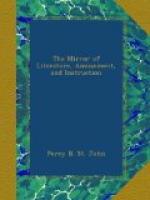From the scarcity of the Chica, its employment is almost exclusively confined to the chiefs and higher orders, their nobility. The rest must be contented with Arnotta, or Poncer mixed with the oil of Carapa, a portion of which, with the Balsam of Aracousiri, mixed with these paints, imparts to them a very delightful odour. The toilet, therefore, of the rude tribes is as simple as their manners and mode of life, their chief material being perfume, and all being carried in a little gourd.
The Chica is not merely esteemed as a pigment, but is considered in the Orinoko as the most sovereign remedy for erysipelas, where that complaint is very prevalent. It is simply made with water into a paste, thinly spread on old linen or cotton, and applied as a plaster to the inflamed part.—Abridged.
Indian Graters.
The Tacumas (Indians) are the fabricators of those curious Cassada Graters, which are considered superior to all others by those who are acquainted with them. They are made of a very hard wood, studded over with pointed flint stones, and fixed by a kind of cement and varnish of surprising durability; the substance being at the same time a strong cement and transparent varnish. These Cassada Graters are scarcely, if at all, known on the coast, or in the European settlements.—Jameson’s Journal.
Wild Bulls.
In the province of San Martin, in South America, M. Roulier saw wild bulls feeding in the llanos among domestic cattle. These animals pass their morning in the woods, which cover the foot of the Cordillera, and come out only about two in the afternoon to feed in the savanna. The moment they perceive a man they gallop off to the woods.
Mount Souffre.
During the eruption of this volcano in 1812, the explosions were heard at 600 or 700 miles distance; and cinders were taken from the deck of a vessel 150 miles distant.
Force of Running Water.
In August, 1827, the small rivulet called the College, at the foot of the Cheviot Hills, was so swollen by the heavy rains, that the current tore away from the abutment of a mill dam, a large block of stone, weighing nearly two tons, and transported it to the distance of a quarter of a mile.
Cement.




